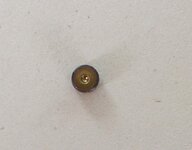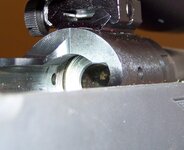- Messages
- 2,457
- Reactions
- 1,965
First off, I want to state, I bought the rifle I am shooting from a person on this board. I am still super happy with it, and am not bashing the gun, just trying to figure out what went wrong. I think it is cleanliness related, and yes I cleaned it before I shot it.
I was out shooting my new to me 22-250. I had shot 25 rounds of Hornady V-MAX 55 gr through it and after shooting round #26 the bolt was extremely hard to pull back. Once I got the bolt back, and realized no casing was coming with it, I saw the extractor had been blow sideways and the detent ball had dropped out. I got it all back together and got the case out and this is what I found.
The casing and primer were separated, the casing looked like this

And the primer looked liked this. I've never seen a "flattened" primer before, but this was the flattest I've ever seen. No ridges around the indentation from the firing pin striking it.

I stopped shooting and tried to figure out what happened. The ammunition was new, not reloads and after a few minutes with a set of calipers it all appeared to be uniform. I had a few instances were the bolt was hard to close, but I chalked that up to a new gun and me not being use to it. This casing what NOT one of those instances. I got my flash light and checked the chamber and found something crushed on the side wall.

I didn't clean it yesterday it was past my bed time, so when I got home form work I looked at it again. Sure enough something in the chamber. I scraped at it today and got it to come lose, in pieces and it appears to be dirt, like dirt from the ground. I don't know where it came from or how it got in there, but would that be enough to cause the failure seen above? I guess it could have been something more substantial and the pressure in the chamber just destroyed it.
The casing show no sign of denting, neither do any of the others fired immediately before it. Should I be buying a "Go" gauge to check just to make sure this isn't a head space issue? I just want to figure it out, I've never had a failure like this.
I was out shooting my new to me 22-250. I had shot 25 rounds of Hornady V-MAX 55 gr through it and after shooting round #26 the bolt was extremely hard to pull back. Once I got the bolt back, and realized no casing was coming with it, I saw the extractor had been blow sideways and the detent ball had dropped out. I got it all back together and got the case out and this is what I found.
The casing and primer were separated, the casing looked like this

And the primer looked liked this. I've never seen a "flattened" primer before, but this was the flattest I've ever seen. No ridges around the indentation from the firing pin striking it.

I stopped shooting and tried to figure out what happened. The ammunition was new, not reloads and after a few minutes with a set of calipers it all appeared to be uniform. I had a few instances were the bolt was hard to close, but I chalked that up to a new gun and me not being use to it. This casing what NOT one of those instances. I got my flash light and checked the chamber and found something crushed on the side wall.

I didn't clean it yesterday it was past my bed time, so when I got home form work I looked at it again. Sure enough something in the chamber. I scraped at it today and got it to come lose, in pieces and it appears to be dirt, like dirt from the ground. I don't know where it came from or how it got in there, but would that be enough to cause the failure seen above? I guess it could have been something more substantial and the pressure in the chamber just destroyed it.
The casing show no sign of denting, neither do any of the others fired immediately before it. Should I be buying a "Go" gauge to check just to make sure this isn't a head space issue? I just want to figure it out, I've never had a failure like this.











